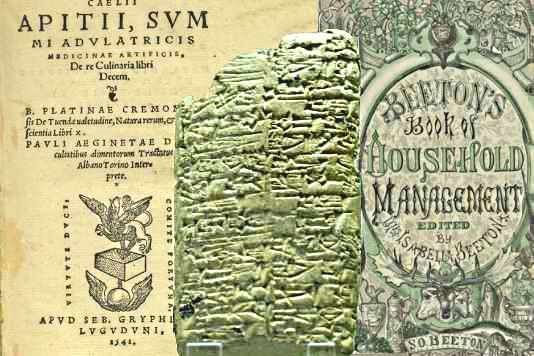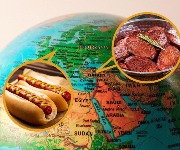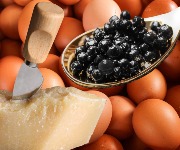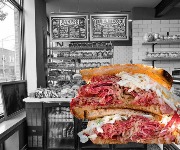The history of cookery books

Matt Brady investigates the rise of the written recipe through the ages, and some of the foods enjoyed in bygone eras.
When did food writing begin? How has it developed through the history of the human race? And what were the first recipes ever written?
Though food writing was originally solely reserved for the recording of recipes, now everything and anything to do with food is documented and discussed. You only need to see the topics that the lovefood team write about to prove that point.
I can’t hope to cover the full story of food writing in a single article, but hopefully this will serve as a springboard for those interested in the topic – and please do tell us about other interesting historical food books in the comments below!
The earliest foodies
 The first known recorded recipes date from around 1600 BC. Jean Bottéro, in his book The Oldest Cuisine in the World: Cooking in Mesopotamia, states that around 40 recipes were recovered from this early period of culinary skill.
The first known recorded recipes date from around 1600 BC. Jean Bottéro, in his book The Oldest Cuisine in the World: Cooking in Mesopotamia, states that around 40 recipes were recovered from this early period of culinary skill.
A delicious recipe for turnips stewed in blood was among the recipes found on cuneiform tablets (an example of which is pictured left) stored at Yale University, known as the Yale Babylonian Tablets.
In the more recent, but still distant, past was the Greek 'Mithekos', who hailed from Syracuse. He’s the first chef we know by name, says Linda Civitello in Cuisine and Culture: A History of Food and People, but unfortunately his writings are lost – we only know about him because of references to him in the work of his contemporaries.
 The Apicius De Re Coquinaria (Art of Cooking), which is commonly known as the Apicius, was compiled around the 4th-5th century AD. It lacks detailed instructions for the most part, which suggests that it was made for use by experienced cooks. Recipes include ‘conditum paradoxum’ (fine spiced wine) and ‘cochleas lacte pastas’ (milk-fed snails). Yummy.
The Apicius De Re Coquinaria (Art of Cooking), which is commonly known as the Apicius, was compiled around the 4th-5th century AD. It lacks detailed instructions for the most part, which suggests that it was made for use by experienced cooks. Recipes include ‘conditum paradoxum’ (fine spiced wine) and ‘cochleas lacte pastas’ (milk-fed snails). Yummy.
To make the wine, the instructions state to put six parts honey and two parts wine into a copper bowl and heat it over a slow fire, constantly stirring. As it boils, add a dash of cold wine, remove from the heat and skim. Repeat two or three times. Add crushed pepper, mastich, laurel leaves, saffron and date stones. Then add another eighteen parts light wine, and filter through crushed charcoal to clarify.
Medieval munchies
 The Forme Of Cury is an English cookbook that was compiled (according to its cover) in about 1390 AD, by the 'Master-Cooks of King Richard II', bearing all the honour of the royal chefs.
The Forme Of Cury is an English cookbook that was compiled (according to its cover) in about 1390 AD, by the 'Master-Cooks of King Richard II', bearing all the honour of the royal chefs.
It was later presented to Elizabeth I. The title comes from the French 'cuire' (to cook), and means ‘Forms of Cooking’. It contains around 200 recipes, though this varies depending on which edition you look at. They tend to be quite meat-heavy and as such were likely to have been enjoyed exclusively by the very wealthy.
Here’s an extract for pigs in sage sauce – the letter þ is called 'thorn' and is pronounced ‘th’ as in ‘then’. A modern English version of the recipe can be found underneath.
Pygges in sawse sawge
Take Pigges yskaldid and quarter hem and seeþ hem in water and salt, take hem and lat hem kele. take persel sawge. and grynde it with brede and zolkes of ayrenn harde ysode. temper it up with vyneger sum what thyk. and, lay the Pygges in a vessell. and the sewe onoward and serue it forth.
Pigs in sage sauce
Take scalded pigs (presumably the pig carcasses had to be washed down in a boiling bath prior to this), quarter them and boil them in water and salt. Take them and let them cool. Take parsley and sage, and grind them with bread and yolks of hard-boiled eggs. Season with somewhat thick vinegar. Lay the pigs in a vessel, cover it with the sauce and serve.
Refining in the Renaissance
 Gervase Markham’s The English Huswife, containing the inward and outward Vertues which ought to be in a Compleat Woman was first published in 1615. Dedicating the work to the “general good of this NATION”, Markham outlines the role of the housewife, who “must be religious” and “temperate”, while the husband is the “father and master of the family”. A view that probably wouldn't make him too popular today.
Gervase Markham’s The English Huswife, containing the inward and outward Vertues which ought to be in a Compleat Woman was first published in 1615. Dedicating the work to the “general good of this NATION”, Markham outlines the role of the housewife, who “must be religious” and “temperate”, while the husband is the “father and master of the family”. A view that probably wouldn't make him too popular today.
But this marks a significant cultural turning point – it's a book containing recipes specifically for use by women working in the household, not by cooks. Not only that, but it describes the housewife's role in the family: she should be a gardener, cook, and be able to cure sickness suffered by her family.
To stew a pike, says Markham, the housewife should dress it, then cover it with white wine, adding currants, sugar, cinnamon, barberries and “as many Prunes as wil serve to garnish the dish”, then stew until the fruit is soft.
Then she should stir up a sauce using a couple of egg yolks and a spoonful of cream with a lump of butter, then serve with sugar, prunes and barberries, plus slices of oranges and lemons.
Medicine
Two of the more interesting books to come out of the 1600s were Nicholas Culpeper’s The English Physician (1652) and The Complete Herbal (1653). These contain a wealth of suggestions as to the medicinal uses of hundreds of plants. They're not cookery books as such, but they do give a fascinating insight into the world of medicine four centuries ago. Culpeper reveals the uses he believed everyday plants like garlic, leeks and onions had. You can browse The Complete Herbal here:
One of Culpeper’s concoctions is the “juice of Lettuce mixed or boiled with Oil of Roses, applied to the forehead and the temples”, which apparently “procures sleep, and eases the headache proceeding of an hot cause.” Let us know how you get on with that one…
The 18th and 19th centuries
 Eliza Acton first introduced the practice of including lists of ingredients and cooking times with her recipes, and this was copied by Mrs Beeton in her Book of Household Management, which is probably the most iconic cookery book in British history. Though supposedly a general household book, it's predominantly a cookbook – by 1906, editions of the book had 3,931 recipes.
Eliza Acton first introduced the practice of including lists of ingredients and cooking times with her recipes, and this was copied by Mrs Beeton in her Book of Household Management, which is probably the most iconic cookery book in British history. Though supposedly a general household book, it's predominantly a cookbook – by 1906, editions of the book had 3,931 recipes.
She lists animal joints and their use, historical comments about various breeds, expected cost to make the dishes and even gives dinner plans through the 12 months of the year for both large and family groups. Her recipe for orange salad is as follows:
“Ingredients: 6 oranges, 1/4lb. muscatel raisins, 2 oz. of pounded sugar, 4 tbsps brandy.
"Peel 5 of the oranges; divide them into slices without breaking the pulp, and arrange them on a glass dish. Stone the raisins, mix them with the sugar and brandy, and mingle them with the oranges. Squeeze the juice of the other orange over the whole, and the dish is ready for table. A little pounded spice may be put in when the flavour is liked; but this ingredient must be added very sparingly.
"Average cost, 1s. Sufficient for 5 or 6 persons.”
Contemporary cooking
Cookery books are now published in their hundreds every year. Recipes are disseminated online in their thousands (by sites such as lovefood.com!) and people can figure out what they’re having for tea by perusing recipes on the go on their mobiles.
You can even take a masterclass in food writing these days, a clear sign of our obsession with food. People not only want to eat it, but read and write about it too. It's a mainstream interest, and not just a curiosity reserved for professional chefs.
If you decide to try out any of the recipes here, please tell us how it went in the Comments below. And if you have any other interesting recipes from times gone by, do share those too.
Clay tablet picture attributed to Jastrow, other images public domain.
You might also like:
10 recipes that changed the world
The cookery books chefs reach for
Most Recent
Comments
Be the first to comment
Do you want to comment on this article? You need to be signed in for this feature








